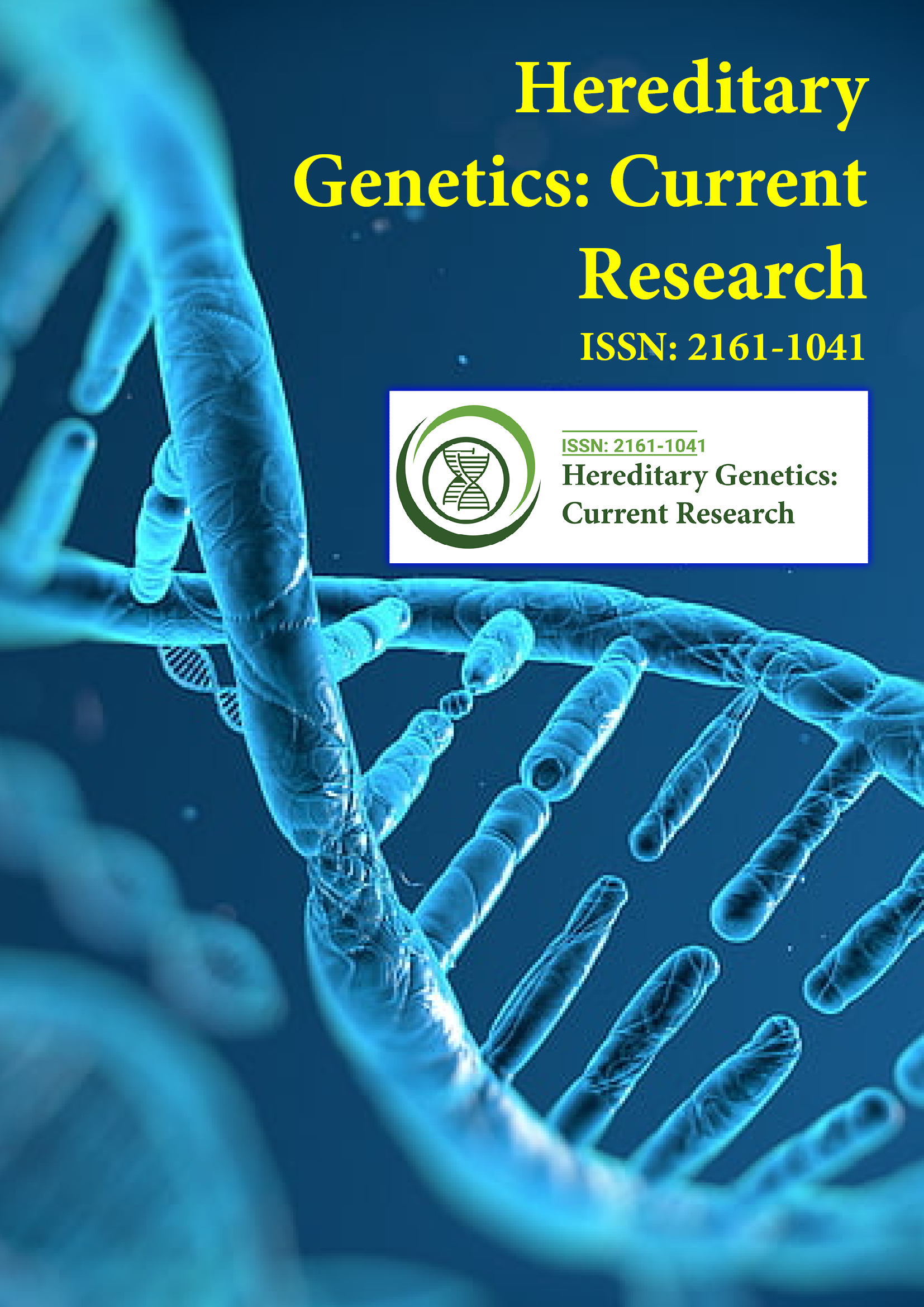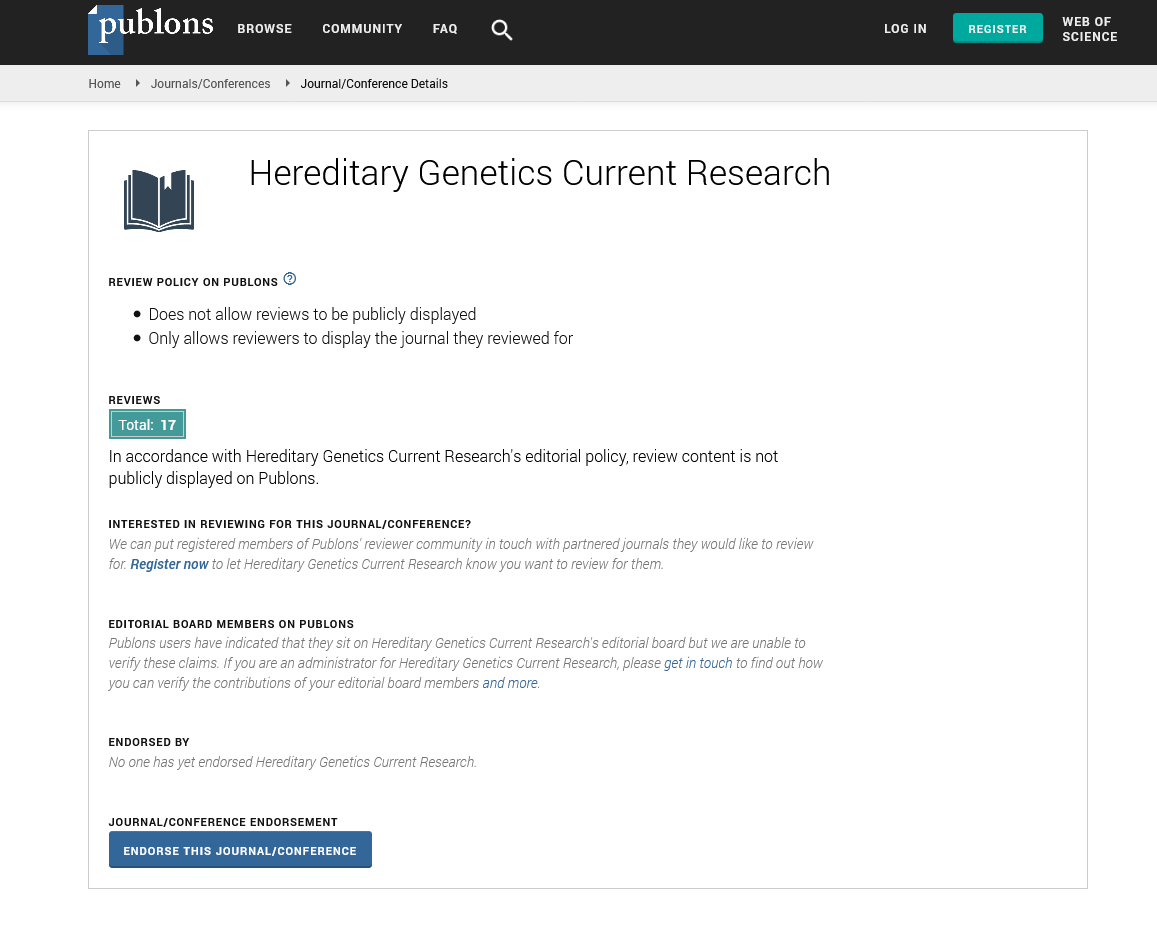Indexed In
- Open J Gate
- Genamics JournalSeek
- CiteFactor
- RefSeek
- Hamdard University
- EBSCO A-Z
- NSD - Norwegian Centre for Research Data
- OCLC- WorldCat
- Publons
- Geneva Foundation for Medical Education and Research
- Euro Pub
- Google Scholar
Useful Links
Share This Page
Journal Flyer

Open Access Journals
- Agri and Aquaculture
- Biochemistry
- Bioinformatics & Systems Biology
- Business & Management
- Chemistry
- Clinical Sciences
- Engineering
- Food & Nutrition
- General Science
- Genetics & Molecular Biology
- Immunology & Microbiology
- Medical Sciences
- Neuroscience & Psychology
- Nursing & Health Care
- Pharmaceutical Sciences
Commentary - (2022) Volume 11, Issue 3
Genetic Testing Purposes in Medical Management and Personal Decision Making
Nancy Neufeld-Kaiser*Received: 02-May-2022, Manuscript No. HGCR-22-17213; Editor assigned: 06-May-2022, Pre QC No. HGCR-22-17213 (PQ); Reviewed: 19-May-2022, QC No. HGCR-22-17213; Revised: 26-May-2022, Manuscript No. HGCR-22-17213 (R); Published: 03-Jun-2022, DOI: 10.35248/2161-1041.22.11.212
Description
Human DNA, RNA, chromosomes, and proteins are analyzed in genetic "tests" to look for anomalies connected to inherited diseases. Tests can look at markers that are co-inherited with a disease-causing gene, the protein products of genes, the entire chromosome, or the DNA or RNA that make up a gene. Although these genetic tests need only easily accessible blood samples, genetic testing involves special considerations.
Uses of Genetic Tests
Genetic tests can serve different purposes. These include
• Diagnostic testing
• Predictive testing
• Carrier testing
• Prenatal testing
• Preimplantation testing
• Newborn screening
Diagnostic testing
Diagnostic genetic testing, like other types of diagnostic testing, is used to determine whether a symptomatic person has a genetic condition that is known or suspected to exist. DNA-based testing may offer the same information at a much low cost and frequently with less risk to the patient, despite the fact that there are frequently other ways to obtain a diagnosis.
Predictive testing
An asymptomatic family member who is at risk for a genetic illness can have their genetic status determined through predictive testing. It is usually necessary to identify the precise illness-causing mutation in a family member with the condition prior to doing predictive testing. Pre-symptomatic and predispositional predictive tests are the two types available. As an illustration of pre-symptomatic testing, consider Huntington's disease. If the gene mutation is present in a healthy person, symptoms will undoubtedly develop if that person lives long enough. Predictive tests needs to be tailored to personal preferences, family needs and experiences.
An autosomal dominant neurologic condition with an average onset age of five decades is Huntington's disease. Memory loss and personality changes are frequent early warning indicators that eventually lead to dementia, involuntary movement disorder, and death.
An example of pre-dispositional testing is the BRCA1 gene susceptibility test, the discovery of a specific gene mutation indicates a probability that breast cancer will arise. In contrast to predictive testing, pre-dispositional testing does not guarantee a person will develop a condition if they test positive. A negative test result does not change the underlying population-based risk to develop the condition. Furthermore, evaluating one gene for predisposition to a common disorder does not test for all components. The initial studies on which they are based were high-risk families, where other unexplained factors may be adding to risk. As a result, the hazards associated with favorable outcomes may be contributing to risk.
It is appropriate for the patient and the doctor to discuss before conducting predictive testing if early diagnosis will lead to medical measures to reduce morbidity or death or whether testing is meant to facilitate individual decision making. Patients must give their fully informed consent after carefully considering the advantages and disadvantages of knowing the test results. In addition to pre-test guidance from a genetics specialist, follow up may be necessary, particularly by specialists.
Many ethical and practice standards have yet to be established in the field of medical genetics because of its youth. For instance, where there is no appropriate medical intervention available, the American College of Medical Genetics (ACMG) and National Society of Genetic Counselors (NSGC) advice against evaluating asymptomatic children at risk for adult-onset disease.However,it may be argued that there may be compelling reasons for parents or other family members to be aware of the existence of a paticular gene mutation in a child at risk.
Carrier testing
Carrier testing is used to find people who have a gene mutation for an illness that is inherited in an X-linked or autosomal recessive way. Typically, the carrier does not exhibit diseaserelated symptoms, but rather wants knowledge to enable informed reproductive decisions. Pretest and Posttest Counseling are equally crucial given that the results may have societal and personal repercussions even though the issues are very different from predictive testing. Pregnancy without prenatal testing, pregnancy with prenatal testing, preimplantation diagnosis, pregnancy by egg or sperm donation, parenting through adoption, or infertility are all reproductive choices that may need to be explored with carriers depending on the genetic issue.
Prenatal testing
Prenatal testing is done to determine a pregnancy's genetic status when it may result in a genetic condition. Advanced mother age, family history, ethnicity, or abnormal prenatal ultrasonographies are risk factors for some genetic disorders. There are currently several prenatal diagnostic options available, including maternal serum screening, the invasive amniocentesis and chorionic villus sample procedures, which are generally available, and the more highly specialized placental biopsy and periumbilical blood sampling procedures. The dangers of invasive prenatal testing for the developing foetus underscore the value of comprehensive genetic counselling and informed consent. Prenatal testing for curable genetic disorders and for genetic disorders with adult onset is debatable, necessitating careful assessment of the benefits and drawbacks.
Preimplantation testing
Preimplantation testing is used to select the early embryos produced through in vitro fertilization for implantation. Testing offers an alternative to prenatal diagnosis and pregnancy termination by determining whether the embryos are free of a certain genetic disease. Only a tiny number of illnesses are covered by such testing, which is only done at specialized facilities. Preimplantation testing is expensive and frequently not covered by health insurance.
Newborn screening
Early detection of hearing loss and metabolic abnormalities allows for the earliest possible start of treatment or intervention for serious illnesses. Although state laws differ, many newborn screening programs are required by law. The tests themselves are not diagnostic; rather, they highlight newborns who should undergo additional testing.
Citation: Neufeld-Kaiser N (2022) Genetic Testing Purposes in Medical Management and Personal Decision-Making. Hereditary Genet. 11:212.
Copyright: © 2022 Neufeld-Kaiser N. This is an open-access article distributed under the terms of the Creative Commons Attribution License, which permits unrestricted use, distribution, and reproduction in any medium, provided the original author and source are credited.

